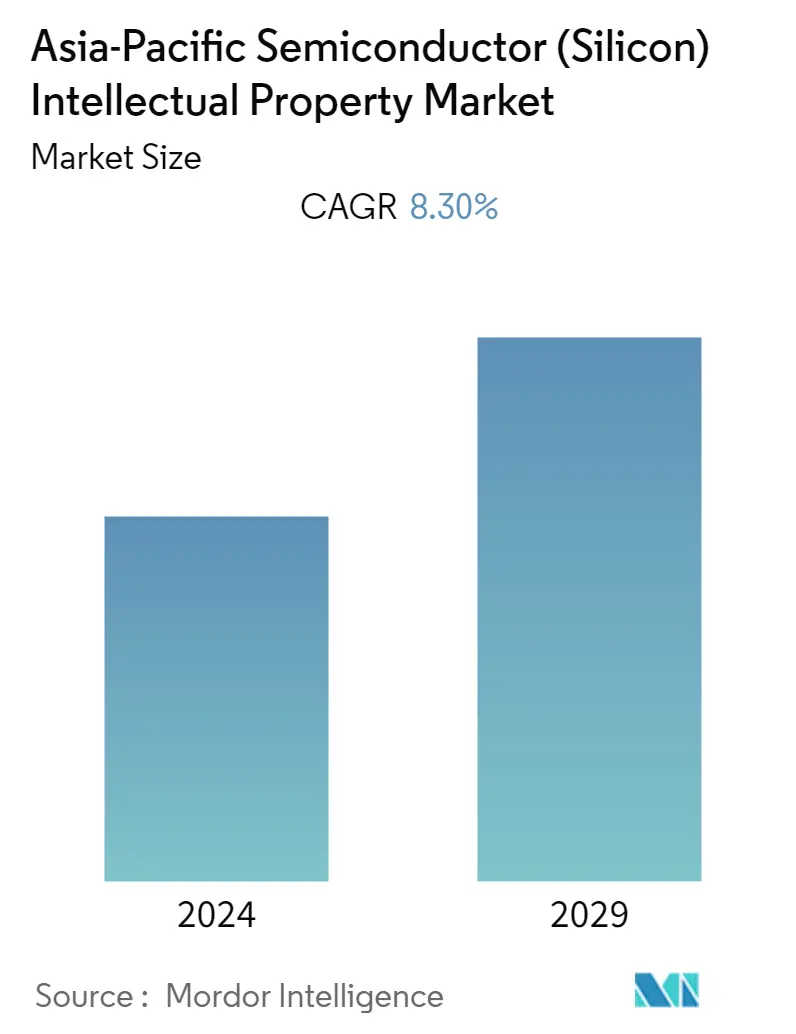Market Size of Asia-Pacific Semiconductor (Silicon) Intellectual Property Industry

| Study Period | 2019 - 2029 |
| Base Year For Estimation | 2023 |
| Forecast Data Period | 2024 - 2029 |
| Historical Data Period | 2019 - 2022 |
| CAGR | 8.30 % |
| Market Concentration | Low |
Major Players*Disclaimer: Major Players sorted in no particular order |
Need a report that reflects how COVID-19 has impacted this market and its growth?
APAC Semiconductor (Silicon) Intellectual Property Market Analysis
The semiconductor (silicon) intellectual property market is expected to register a CAGR of 8.3% during the forecast period (2021-2026). The market is proliferating in China, with many chip design companies striving for self-reliance amid an escalating US-China technology rivalry. China's growing semiconductor landscape is also a direct driver of the market for semiconductor intellectual property. The rapid increase in semiconductor equipment is an indicator that the industry is growing in the country. According to SEMI, China vaulted to the number one spot for semiconductor equipment in 2020 with an annual sales growth of 39% compared to the previous year.
- The government has also played a significant role in molding the market in China. Since August 2020, the government of China has issued several new related policy measures to boost the development of its semiconductor industry. To begin with, in August 2020, China's State Council issued a Notice on different policies to promote the development of the IC industry and software industry.
- Also, in March 2021, the government issued several implementing measures that include criteria companies must meet to qualify for government preferences, tax, and tariff provisions. In addition, China's new policies encourage the United States and foreign semiconductor companies to transfer specific technology, intellectual property, research, and development to operations in China, driving growth in the domestic market. Furthermore, such policies offer preferential terms over the next ten years, including IP protection, tax, and financing for companies willing to establish capabilities, including production facilities in China.
- Taiwan is one of the largest producers of semiconductors in the world. The country is home to Taiwan Semiconductor Manufacturing Limited (TSMC), United Microelectronics Corporation, and other prominent players, driving the country's semiconductor industry. The semiconductor market in the country is also growing due to support from the government. Recently, the National development fund announced that between 2021 and 2025, the Taiwan companies have planned USD 107 billion investment for the semiconductor industry's growth. The government is also helping develop new semiconductor technologies with funding support and talent recruitment programs. Therefore, the increase in the semiconductor market leads to a rise in intellectual properties as well.
- However, The complexity of system on chip (SoC) designs is outpacing systems engineering capabilities. Increasing design complexity has given rise to increasing data size and thus, making semiconductor development more challenging than before, and is restraining the growth of the studied market. Further, the overall semiconductor market witnessed significant growth in 2020 compared to 2019, despite the COVID-19 pandemic, and it is further expected to grow in the coming years, owing to massive end-user demand. This has also supported the growth of the market vendors.
- For instance, in October 2020, Cadence reported a revenue of USD 667 million in the third quarter of 2020, compared to the revenue of USD 580 million reported for the same period in 2019. The company also raised its 2020 revenue and earnings forecast due to higher second-half hardware and IP sales activity in China and continuing progress in the system design and analysis business. For the fourth quarter of 2020, the company expected the total revenue in the range of USD 720 million-USD 740 million.
